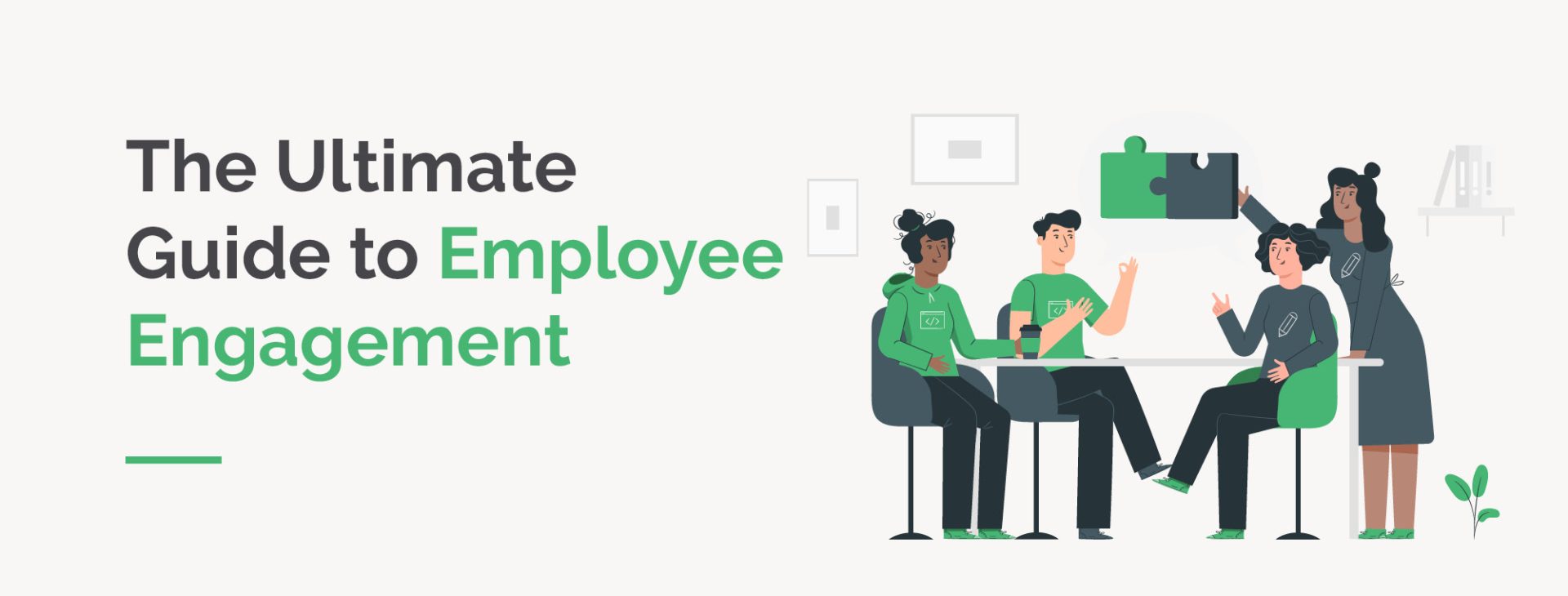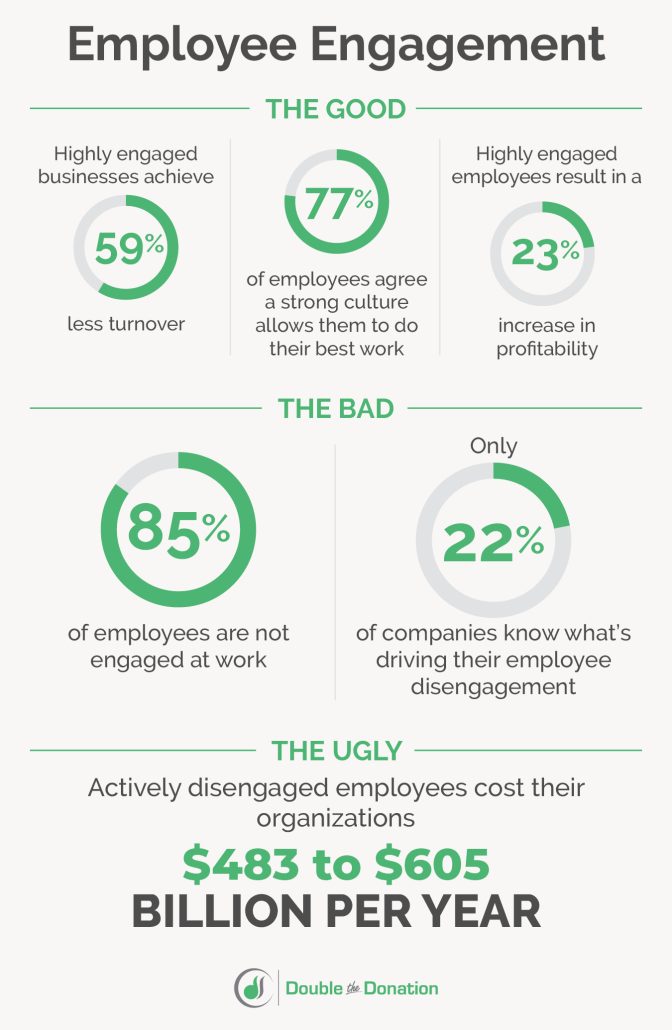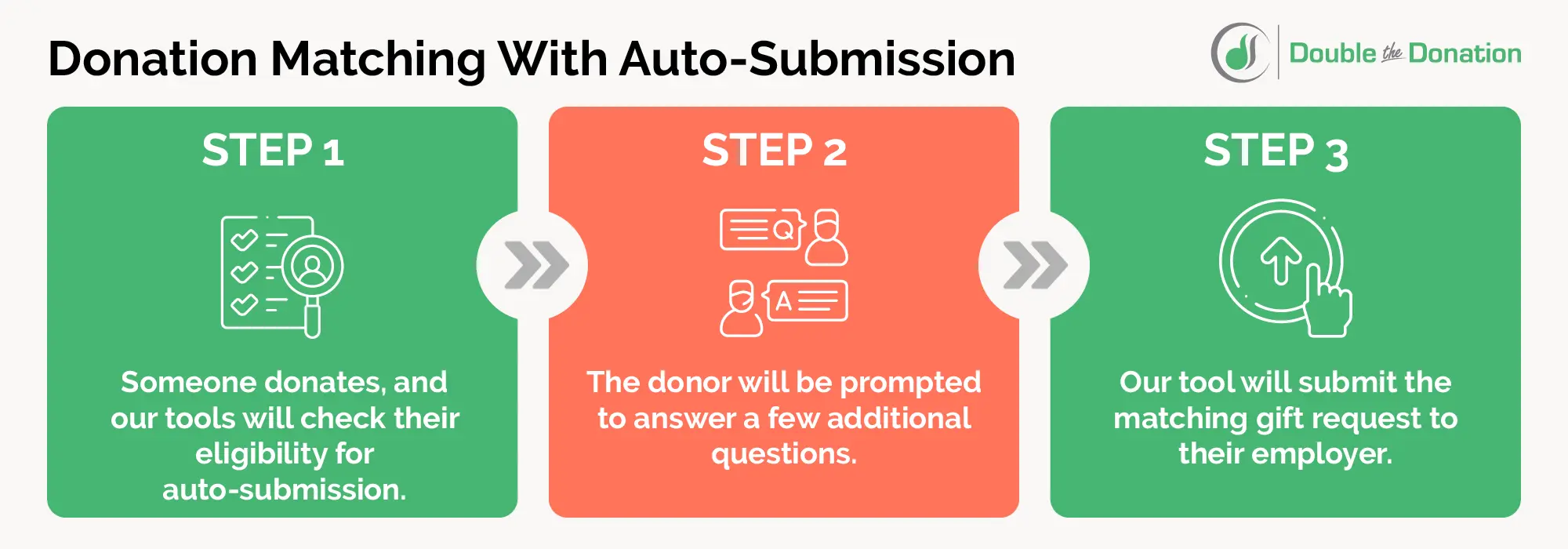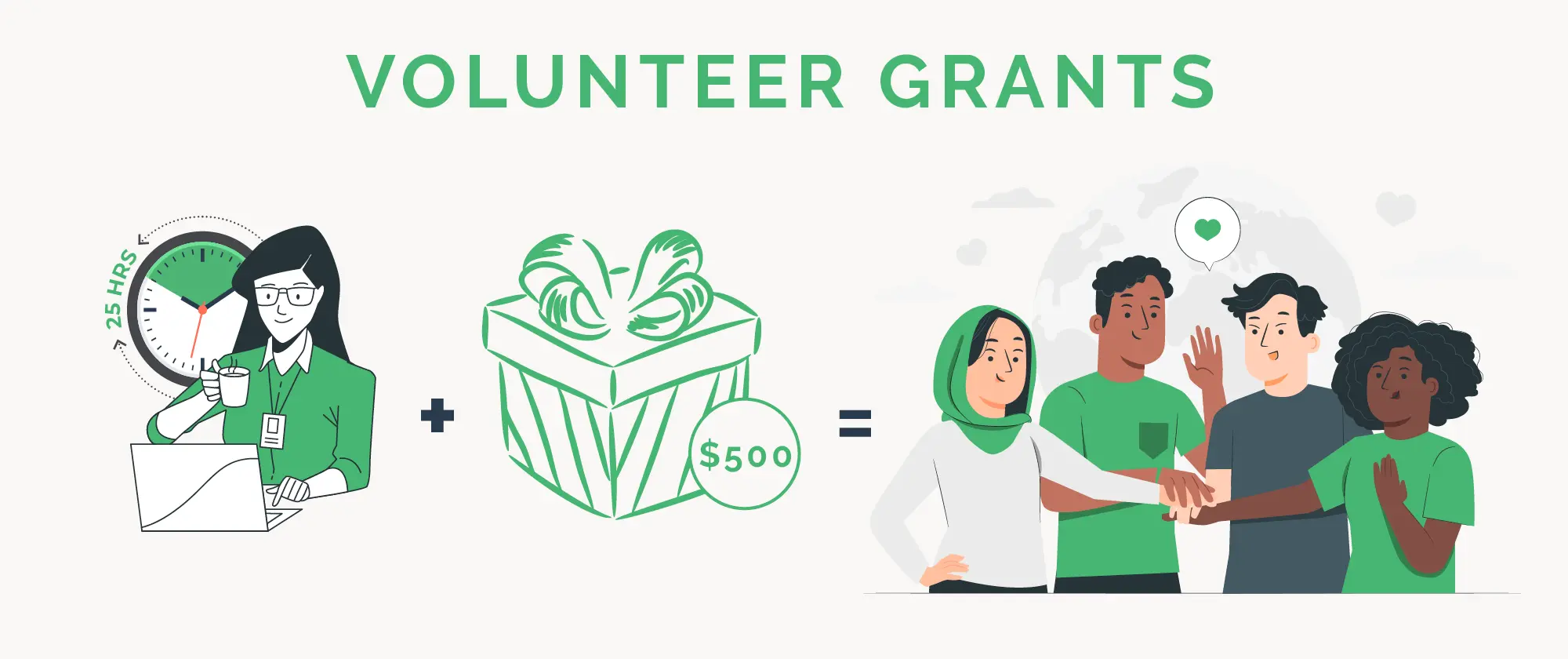From Disengaged to Inspired: A Guide to Employee Engagement
As a company, managing employee expectations and productivity can be a challenge. You want to keep them feeling satisfied and fulfilled in their work, but how exactly do you accomplish that?
In this guide, we’ll explore the key principles and strategies for sustaining employee engagement. Specifically, we’ll cover:
- The Basics of Employee Engagement
- 6 Ideas for Effective Employee Engagement
- How to Measure Employee Engagement
Whether you’re starting from scratch or looking to amplify your existing employee engagement initiatives, these insights will help you create an environment where employees feel valued, motivated, and fully invested in their work.
The Basics of Employee Engagement
Before you attempt to engage your employees, ensure that you have foundational knowledge to guide your strategies.
What is employee engagement?
Employee engagement refers to the commitment that employees have to their work, team, and organization. It is a measure of how motivated employees are to go to work each day and how passionate they are about contributing to the success of the company.
Why is employee engagement important?
Recent workplace statistics prove that engaged employees are invested in their work, leading to higher levels of innovation, better customer service, and increased job performance. They are also less likely to leave your company, reducing turnover and the associated recruitment and training costs.
Take a look at these combined polls that indicate the good, the bad, and the ugly as they relate to employee engagement:
To summarize, 77% of employees believe a strong workplace culture allows them to do their best work. Companies that commit to creating a strong culture see 59% less turnover and a 23% increase in profitability.
However, an overwhelming 85% of employees admit to not being engaged at work, and only 22% of companies know what’s driving their disengagement, which can be detrimental as disengaged employees cost their organizations upwards of $605 billion dollars a year.
Who should be in charge of employee engagement?
Employee engagement is a collective responsibility that involves multiple stakeholders within an organization. While there may not be a single individual solely in charge of employee engagement, the HR department often plays a central role. HR professionals can develop programs aimed at increasing engagement—such as training, recognition, and feedback mechanisms—and monitor the success of these initiatives through surveys.
Managers also have a significant influence on employee engagement, as they directly interact with their teams and can motivate, mentor, and provide suggestions for growth opportunities. Therefore, it’s crucial for organizations to foster a shared responsibility for engagement, where everyone contributes to creating a positive and engaging workplace culture.
6 Effective Employee Engagement Ideas
Now that you have a basic understanding of what employee engagement is and why it’s important, you can begin implementing strategies to engage, retain, and empower your workforce.
1. Encourage Corporate Giving.
If you haven’t already, launch a corporate social responsibility (CSR) program that emphasizes your commitment to ethical, social, and environmental justice. CSR activities often involve collaboration, whether it’s choosing a charitable cause to support or volunteering as a group. These experiences can strengthen team bonds and foster a sense of community among employees, leading to improved working relationships and a more engaged workforce.
Two of the most impactful employee giving programs are matching gifts and volunteer grants. Both emphasize that you want to support the same causes your employees care about. Thankfully, these are also the easiest programs to implement! Let’s explore them both.
Matching Gift Programs
Through a matching gift program, you agree to match an employee’s donation based on a predetermined ratio. Let’s say they give $50 to an eligible organization. If your company matches gifts at a 1:1 ratio, you’d also give $50, effectively doubling the initial contribution. If you offer a generous 2:1 ratio, you’d contribute $100, totaling $150 for the nonprofit.
Employees often seek more from their jobs than just a paycheck; they look for purpose and meaning in their work. Matching gift programs make them feel part of something bigger when they see their employer match their donations to causes they care about. When employees see that you value their charitable efforts, they’re more likely to take pride in being part of your company.
If this seems like an employee engagement opportunity you can’t pass up, here’s what the process looks like:
- An individual donates to a nonprofit organization.
- Using an employer search tool, they research their eligibility.
- If eligible, they fill out a match request form.
- Your company reviews the request and confirms the donation with the nonprofit.
- Once confirmed, your company donates to the nonprofit.
While developing your matching gift program, try to eliminate as many barriers to participation as possible. Traditionally, submitting a match request involves some hands-on effort, requiring employees to manually fill out forms and upload donation receipts. Instead, try auto-submission.
Auto-submission is a trailblazing feature made available through Double the Donation and its CSR platform partners—including Millie, Selflessly, POINT, and more. These platforms have earned a CLMA designation for their seamless integration of matching gifts and auto-submission functionality, making employee engagement in the programs easier than ever.
When your company leverages one of these corporate giving solutions to facilitate its matching gift program, all employees have to do is provide their corporate email address (or another piece of identifying information) when donating, and the software will take care of the rest.
Volunteer Grant Programs
Our corporate volunteer research indicates that 84% of employers think volunteerism is an effective way to engage employees. Try organizing company volunteer days to encourage groups of employees to volunteer together, or offer volunteer time off (VTO) to let individual employees volunteer during work hours.
To make employees’ impact go further, offer volunteer grants. Through a volunteer grant program, your company will provide financial donations to nonprofits where your employees volunteer. You can either donate on an hourly basis or donate a predetermined amount once a certain threshold is met. For example, you might offer $20 per volunteer hour, or you might offer a $500 grant once an employee donates 25 hours.
This type of volunteer program acknowledges and monetizes the personal time employees dedicate to philanthropy. You’ll reinforce a culture of giving and boost morale by valuing employees’ passions.
Overall, aligning corporate giving with employees’ volunteer interest will help your company amplify its social impact and foster a more engaged and committed workforce.
2. Promote Professional Development.
Employees are more likely to feel engaged when they see a clear path forward within your organization. Create opportunities to sharpen their skills, knowledge, and career development through:
- Training: In addition to initial onboarding and orientation, offer ongoing training programs that focus on both job-specific skills and soft skills like communication, leadership, and problem-solving. Use a mix of training methods, including in-person workshops and online courses, to accommodate various learning styles. For instance, our Matching Gift Academy provides a variety of video-based training modules that teach strategies to solve matching gift roadblocks and manage the matching gift business process. While ideal for nonprofits, this example shows how you can help employees develop their skills.
- Advancement: Encourage employees to create Individual Development Plans (IDPs) that outline their career goals. Managers should review IDPs with employees during one-on-one meetings and provide guidance on the skills and experience needed for advancement in different roles or departments.
- Mentorship: Implement mentorship or coaching programs where experienced employees can guide and support those looking to advance their careers. These programs can provide valuable insights and networking opportunities for employees.
- Continued education: Offer financial assistance or time off for employees pursuing additional education or certifications related to their roles. Create partnerships with educational institutions or online learning platforms to make learning resources more accessible to employees.
Professional development is an investment in your company’s human capital. Allocate the necessary resources, including budget, time, and personnel, to develop and deliver effective programs.
3. Recognize Employees With Creative eCards.
Chances are, your business already has employee recognition practices in place. For instance, you might offer performance bonuses, public praise, and awards like “Employee of the Month.” While these methods can be effective in engaging employees, they may feel unappreciated if recognition feels routine and uninspired.
Switching things up with an innovative solution like eCards keeps recognition fresh and exciting. Digital thank-you notes can be shared quickly through email, making them a popular choice for instant recognition.
To create thoughtful recognition eCards like the one above, here’s what you should do:
- Choose an eCard creation platform with employee recognition capabilities. It should also offer a variety of templates, customization options, and scheduling features.
- Select an appropriate eCard template that matches the occasion or purpose of recognition, whether it’s for a birthday, work anniversary, outstanding performance, or another event.
- Personalize the eCard by adding the recipient’s name, a heartfelt message, and any relevant images, graphics, or logos. Consider tailoring the message to highlight the specific reason for recognition, such as a recent achievement or milestone.
- Choose the delivery date and method. You can send the eCard immediately or schedule it for later, depending on your preferences.
For more information on how eCards can boost employee engagement, watch this video from our friends at eCardWidget:
The Best Times To Send eCards
While eCards are a powerful employee engagement idea, you need to strategize when you’ll send them for maximum impact.
Here are some of the best times to send eCards to employees:
- Work Anniversaries: A celebratory eCard on each employee’s work anniversary is a great way to recognize their commitment to your organization.
- After Achievements: Send eCards immediately after someone completes a significant project, receives positive customer feedback, or reaches a major milestone to communicate that you value their contributions.
- Holidays: Reach out on festive occasions like Thanksgiving, Christmas, and New Year’s to spread joy and show appreciation.
- Birthdays: Make employees feel special on their birthdays by sending well wishes with an eCard. Your eCard can explain how much you appreciate their contributions and hope they have a wonderful day.
You can even schedule some of these emails to be sent on a specific date, like on holidays, work anniversaries, or other special occasions. For example, eCardWidget offers automated birthday eCards. By turning this feature on, you can automatically send personalized birthday eCards on each employee’s special day.
Simply upload your employees’ birthdays and contact information to the platform. Then, select your birthday eCard designs and write a message or two wishing recipients a happy birthday. If you add multiple birthday eCard designs or messages, the platform will rotate through them, providing a combination that makes each recipient feel special. Timely recognition like this will work wonders for employee engagement!
4. Launch A Workplace Wellness Program.
Prioritizing workplace wellness directly impacts employee health, morale, and productivity and demonstrates your company’s investment in employees’ well-being. This commitment not only fosters a supportive work environment but also enhances employee retention and overall performance, contributing to a more resilient and thriving company.
Show your employees you care by creating a wellness program, aimed at promoting healthy behaviors and supporting employees’ physical, mental, and emotional health through activities and resources. By creating this type of program, you can ultimately foster a healthier and happier workplace.
Best of all, you can use social wellness platforms to streamline your program. As our top recommendation, Givhero offers a suite of features designed to engage employees in wellness and social responsibility efforts, such as:
- Customizable Challenges: Create personalized health and wellness challenges tailored to your workforce, encouraging participation in a fun and engaging way.
- Charitable Donations: Achievements within these challenges are rewarded with donations to charities, linking employee wellness efforts directly to social impact. Employees can choose from Givhero’s Partner Network of over 2.3 million charitable causes.
- Activity Tracking: The platform includes tools for tracking various wellness activities, such as exercise, meditation, or healthy eating. Employees can sync Givhero with apps like Apple Health, Fitbit, and Strava, allowing for easy progress tracking.
- Social Engagement: Features for sharing achievements and participating in group challenges help build a sense of community among employees. People can even support colleagues with applause and badges.
Historically, Givhero has increased employee wellness program participation by 50%+ and reduced HR administration time by up to 80%. Using an app like this will not only motivate employees to maintain a healthy lifestyle but also foster a culture of giving back. Best of all, adminstration will be a breeze.
Overall, Givhero helps companies invest in their employees’ health and the community, making it a powerful tool for boosting employee engagement and fostering a positive workplace culture.
6. Promote Work-Life Balance.
Promoting work-life balance is essential for engaging employees and fostering a healthier, more productive workplace. Set reasonable working hours and encourage employees to disconnect from work when they are off the clock.
Keep in mind that a culture of work-life balance should be cultivated from the top down. Leaders and managers should model this balance by respecting employees’ time and encouraging them to prioritize self-care. Encourage employees to take regular breaks and vacations, setting realistic expectations for response times to emails or work requests outside of regular hours.
By demonstrating a commitment to work-life balance and providing the necessary support, you can create an environment where employees feel engaged in their roles and fulfilled in their personal lives.
5. Foster an Inclusive Work Environment.
Inclusive workplaces foster a sense of belonging among employees, regardless of their background, gender, race, sexual orientation, or other characteristics. When employees feel like they belong, they are more likely to be engaged because they are comfortable being themselves and contributing their unique perspectives.
Here are a few ways to promote a positive and inclusive workspace:
- Implement inclusive hiring practices that consider candidates from various backgrounds, experiences, and perspectives. Ensure that job postings and interview panels are free from bias.
- Establish policies that prohibit discrimination and harassment in all forms, including that based on race, gender, sexual orientation, religion, disability, and age.
- Foster a culture of open and transparent communication where employees feel comfortable expressing their thoughts, concerns, and ideas without fear of retribution.
Creating a positive and inclusive work environment is an ongoing process that requires commitment from all levels of the organization. It’s essential to continually assess and refine your efforts, seek feedback from employees, and adapt to evolving best practices in diversity and inclusion to create a thriving workplace for everyone.
Looking for even more ideas? Check out our list of 50+ employee engagement ideas!
How to Measure Employee Engagement
After launching your engagement initiatives, analyze turnover rates, absenteeism, and performance metrics to determine their effectiveness. Additionally, send out surveys and have one-on-one discussions with employees to gauge their level of commitment to your organization.
Based on their feedback, employees can be grouped into three levels:
- Engaged: Engaged employees are highly committed, enthusiastic, and invested in their work and the organization. They take pride in their roles, often go above and beyond job expectations, and are motivated to contribute to the company’s success.
- Not engaged: These employees often do the minimum required to fulfill their responsibilities and may not actively seek opportunities for improvement or growth. They can become disengaged if their needs and interests are not addressed.
- Actively disengaged: Disengaged employees are disconnected from their work and your organization. They are typically less productive and will eventually leave the organization if their concerns are not addressed.
Identify and take measures to re-engage disengaged employees to prevent further decline in morale and performance.
A Final Note About Employee Engagement
Remember, employee engagement is not a one-time initiative. It’s a continuous journey that requires commitment, dedication, and a genuine desire to create a workplace where employees feel inspired to do their best.
For more information on employee engagement, check out these additional resources:
- Why Workplace Giving Matters for Nonprofits + Companies. Looking to learn more about workplace giving programs? Check out our guide!
- A Full Guide to Employee Engagement Tools + 20 Top Picks. Ready to engage your employees? Learn which tools to leverage in this guide.
- Increase Employee Engagement With Corporate Giving. Corporate giving programs do a lot to increase employee engagement. Learn how in this guide.













